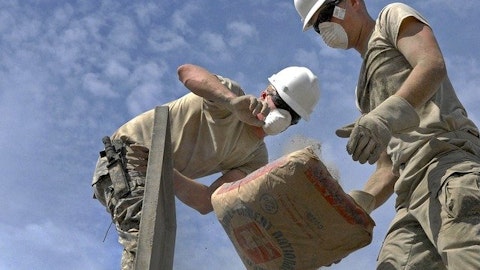Mark Millett: I think one has to recognize that the industry has gone through quite a consolidation comparing it to some years ago and that has allowed sort of market strength or strong market pricing compared to history, and that will continue. The year as it is unfolding, we are entering the year with an absolute solid backlog through the middle of the year for sure. The order input rate is indeed off the kind of the frenetic crazy pace that it was 12-months ago. But it is very, very, very solid, and we believe that it is going to be a very, very good year for us at year-end. And I believe there is some concern maybe as I said earlier, the macro indices may not look as rosy as some would think. And some believe that there is economic uncertainty out there, as I hopefully articulated, we don’t see the gloom and doom that everyone else is seeing it.
Our order input rates across all our sectors with the 1 exception, a little off on residential is solid. And our December bookings record level on a historic basis similarly year-to-date. So we just see strength through the year through our lands through our order book.
Timna Tanners: Okay. Mark, does that strength on volumes, strengthen prices into margins I mean do you expect year-over-year to be up and just like I’m saying it is a big gap. I get that it will be higher than it is been historically, but any color on if we should expect some continuation of what we saw in 2022?
Mark Millett: Well, I think the steel space will — I know I’m saying that the steel space will appreciate from the lows. Obviously, we are seeing the hot-band pricing off the market pricing of 650 and it is up away over 700. In fabrication, the spreads will likely come off a little. They certainly haven’t to any large extent at this point. You are certainly seeing people say, well, our projects are getting delayed, we are not seeing any cancellations at all. We are seeing projects delayed some. But in my mind, it is not an unhealthy thing in all honesty, because it is just protracting or extending the cycle – the business cycle in that arena.
Timna Tanners: Okay, thanks Mark.
Operator: Thank you very much. Your next question is coming from Curt Woodworth of Credit Suisse. Curt your line is live.
Curtis Woodworth: Yes thanks good morning Mark and Theresa, how are you? Good. I just want to follow up on the fabrication comments. So in the past, you have talked about you have had backlog basically priced through the middle part of this year, and I think you had discussed I believe pricing in the 5,000 or higher level. So I just wondered if you could confirm that, that is kind of the price level your backlog is at. And then if you are sold through the first part of this year, I assume you are bidding projects now for can you comment on price levels you see there? And then with respect to some of the delays or project push outs from what we have seen, the data center and some of those areas are still very strong oil the Amazon type warehouse spent a lot of those have been canceled. So if you could just kind of help us maybe understand a little bit of the DNA of the backlog would be helpful.
Theresa Wagler: Good morning Curt. So from the perspective of pricing, Obviously, we are not going to give specific pricing. But you would have seen that the pricing held in very steadily in the fourth quarter from an average perspective. And we have seen very steady pricing in the backlog as well. So I would err on the higher side if you think about what is in the backlog. And that is why we have great confidence in the earnings resiliency of the fabrication business through at least the first half of this year. And the order backlog, it is an interesting question because it is broadened out, wherein as it was very concentrated in warehouses, it is broadened out now into more, I would say, infrastructure type hospitals, schools, churches et cetera, so that is a good thing and that is what we think we are seeing more of.
We expected very strong volumes for fabrication in 2023 from what we are seeing so far. And Mark mentioned the order entry activity is very good from a historical. So then you can contemplate what you think steel prices will be to make an estimation of whether you think we will continue to see expanding spreads in fabrication or not. That is what we saw in the fourth quarter definitively. Mark, do you want to add anything?
Mark Millett: And just the one comment, though, I think it was mentioned that the distribution warehouses are again canceled. We actually are only seeing that in one customer. Well, actually, not a customer of ours, but one company the distribution warehouse business in our backlog is solid and not getting canceled out. So that is not a comprehensive issue. And just to reemphasize what Teresa said on earlier on the reshoring. Reshoring is real. It truly is. That is going to be supportive of that business. And if you look through just the size of some of these factories, the battery manufacturing facilities is a huge, massive, massive facilities that will require a lot of joists and deck. So again, it is off the frenetic pace that we saw, but it is a very, very, very solid sector for us for the rest of the year.
Curtis Woodworth: Okay. I appreciate that. And then just a follow-up on Sinton. What were the volumes shipped this quarter and we look at start-up costs for the year is roughly $430 million. So those material drag on your profitability. Can you comment on maybe when you would expect to maybe breakeven with respect to start-up costs and do you have any guidance for what start-up impact would look like in the first quarter? Thank you.
Theresa Wagler: Yes. So from a volume perspective Curt, Sinton had shipments in the third quarter of around just under 270,000 tons, and it increased to just under 340,000 tons for shipments in the fourth quarter, and we expect to see that improve in the first quarter and then have a significant improvement in the second quarter of 2023. From an impact, we still expect to see losses as they work through the higher-priced pigeon which is obviously matching against lower steel prices than they were at this time last year. And so like it will be – it should improve over the fourth quarter losses pretty significantly, but still be higher than we would like to see maybe around the $10 million mark.
Curtis Woodworth: Great. Thanks very much.
Operator: Thank you. Your next question is coming from Tristan Gresser of BNP Paribas. Tristan your line is live.
Tristan Gresser: Hi, thank you for taking my questions. Maybe just a quick follow-up on Sinton. Are you able to share any EBITDA annual contribution you are expecting for next year or maybe kind of a sense of how this compares versus the normalized EBITDA target you mentioned and given maybe a slower start-up and then some ramp-up of the coating lines as well in Q4 that is going to help. So any kind of a sense you can give us that would be great.
Theresa Wagler: So I think Mark mentioned the ramp-up for the two additional value-add lines that will be in Sinton the third quarter of 2023. Those should ramp, we expect fairly quickly to start benefiting their product mix. We are not going to give full-year guidance for Sinton as far as EBITDA. But I would tell you that I think Curt mentioned earlier on the call, that the losses in 2022 were over $400 million, and it is going to swing to a significant positive for 2023. So just that differential alone will have a significant momentum benefit to our earnings in 2023, but it is just too early for us to give an estimate, but it won’t hit through cycle EBITDA in the year where we are still ramping up production.
Tristan Gresser: Okay. That is really helpful. And my second question is more on the demand side. You talked about steel demand increasing in 2023. Can you give us a sense of what kind of number you are seeing and maybe diving into your key end markets also there if you are able to share some quantitative number that would be great.
Mark Millett: I guess from our perspective, the higher demand translates to, in large part, to price up point and spread support. Our operations are already running at quite a high utilization rate. Further demand, obviously, is certainly going to help our Sinton facility. And given the market sectors, energy is very, very strong in that area in Texas. That is helping us. And the challenges that we are seeing in Mexico and the imports of sheet coming up from Mexico into the Southwest markets, but also even under the Midwest have essentially mitigate they are staying in Mexico now. So that is going to create good demand and great dynamics. So from a market perspective, we will certainly be able to support all the capability that the ramp-up will allow.
Tristan Gresser: Okay, thanks for the color.





